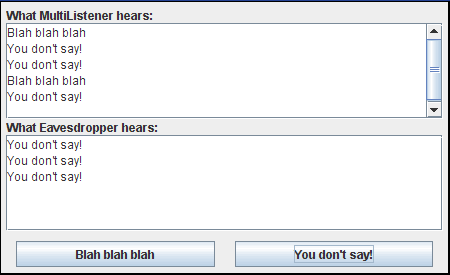Lesson: Writing Event Listeners
Java 教程是为 JDK 8 编写的。本页中描述的示例和实践未利用在后续版本中引入的改进。
事件监听器简介
If you have read any of the component how-to pages, you probably already know the basics of event listeners.
Let us look at one of the simplest event handling examples possible. It is called Beeper, and it features a button that beeps when you click it.
Click the Launch button to run Beeper using Java™ Web Start (download JDK 7 or later). Alternatively, to compile and run the example yourself, consult the example index.

You can find the entire program in
Beeper.java. Here is the code that implements the event handling for the button:
public class Beeper ... implements ActionListener {
...
//where initialization occurs:
button.addActionListener(this);
...
public void actionPerformed(ActionEvent e) {
...//Make a beep sound...
}
}
The Beeper class implements the ActionListener interface, which contains one method: actionPerformed. Since Beeper implements ActionListener, a Beeper object can register as a listener for the action events that buttons fire. Once the Beeper has been registered using the Button addActionListener method, the Beeper's actionPerformed method is called every time the button is clicked.
A More Complex Example
The event model, which you saw at its simplest in the preceding example, is quite powerful and flexible. Any number of event listener objects can listen for all kinds of events from any number of event source objects. For example, a program might create one listener per event source. Or a program might have a single listener for all events from all sources. A program can even have more than one listener for a single kind of event from a single event source.

Multiple listeners can register to be notified of events of a particular type from a particular source. Also, the same listener can listen to notifications from different objects.
Each event is represented by an object that gives information about the event and identifies the event source. Event sources are often components or models, but other kinds of objects can also be event sources.
Whenever you want to detect events from a particular component, first check the how-to section for that component. A list of the component how-to sections is here. The how-to sections give examples of handling the events that you are most likely to care about. In How to Use Color Choosers, for instance, you will find an example of writing a change listener to track when the color changes in the color chooser.
The following example demonstrates that event listeners can be registered on multiple objects and that the same event can be sent to multiple listeners. The example contains two event sources (JButton instances) and two event listeners. One of the event listeners (an instance of a class called MultiListener) listens for events from both buttons. When it receives an event, it adds the event's "action command" (which is set to the text on the button's label) to the top text area. The second event listener (an instance of a class called Eavesdropper) listens for events on only one of the buttons. When it receives an event, it adds the action command to the bottom text area.

试试这个:
- Click the Launch button to run MultiListener using
Java™ Web Start (download JDK 7 or later). Alternatively, to compile and run the example yourself, consult the example index.

- Click the Blah blah blah button. Only the
MultiListenerobject is registered to listen to this button. - Click the You do not say! button. Both the
MultiListenerobject and theEavesdropperobject are registered to listen to this button.
You can find the entire program in
MultiListener.java. Here is the code that implements the event handling for the button:
public class MultiListener ... implements ActionListener {
...
//where initialization occurs:
button1.addActionListener(this);
button2.addActionListener(this);
button2.addActionListener(new Eavesdropper(bottomTextArea));
}
public void actionPerformed(ActionEvent e) {
topTextArea.append(e.getActionCommand() + newline);
}
}
class Eavesdropper implements ActionListener {
...
public void actionPerformed(ActionEvent e) {
myTextArea.append(e.getActionCommand() + newline);
}
}
In the above code, both MultiListener and Eavesdropper implement the ActionListener interface and register as action listeners using the JButton addActionListener method. Both classes' implementations of the actionPerformed method are similar: they simply add the event's action command to a text area.